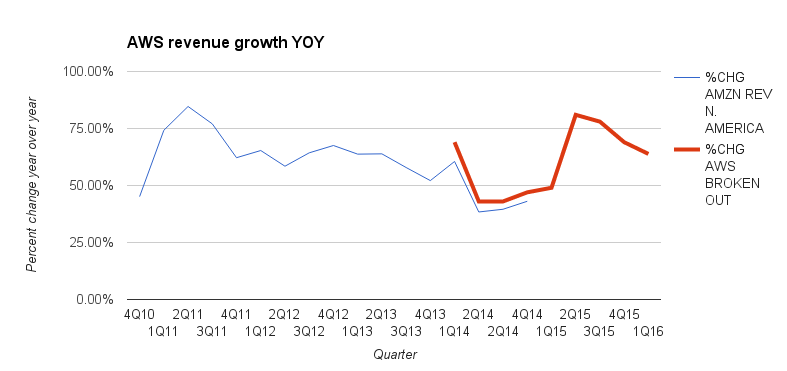Amazon today released its earnings statement for the first quarter of the year, and things are looking up, as usual, for its Amazon Web Services (AWS) public cloud division. AWS fetched $2.56 billion in revenue for the quarter.
Operating income for the business unit came in at $604 million — more than half of the operating income for all of Amazon this quarter! — as a result of $1.85 billion in operating expenses. The AWS operating income is down sequentially from $687 million.
Altogether AWS produced a year-to-year growth rate of 63.8 percent, according to today’s filing — that compares positively with the 49 percent growth rate from the first quarter of 2015. But it’s down sequentially from 69 percent revenue growth in the fourth quarter of 2015.
AWS leads the market for public cloud infrastructure, which comprises compute, storage, networking, and database resources that developers can use to build, test, and run applications on hardware infrastructure that they don’t have to maintain.
June 5th: The AI Audit in NYC
Join us next week in NYC to engage with top executive leaders, delving into strategies for auditing AI models to ensure fairness, optimal performance, and ethical compliance across diverse organizations. Secure your attendance for this exclusive invite-only event.
Major competitors include Microsoft Azure and Google Cloud Platform, but those companies are likely considerably behind 10-year-old AWS in terms of market share.
It’s been one year now since Amazon broke out exact financials for the AWS division for the first time; prior to that AWS was lumped in with the “other” revenue for North America, which included miscellaneous items like advertising services and co-branded credit card agreements.

Above: Revenue growth for Amazon Web Services, updated with data for the first quarter of 2016.
In the past four quarters, AWS has brought Amazon a total of $8.88 billion in revenue. Amazon chief executive Jeff Bezos recently said AWS is “reaching” $10 billion in revenue this year.
Amazon stock was up more than 10 percent in after-hours trading.

